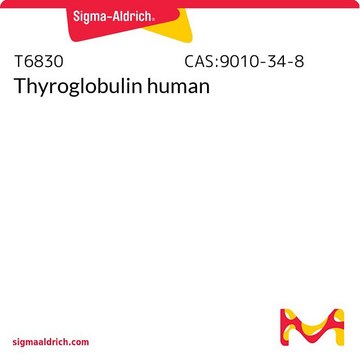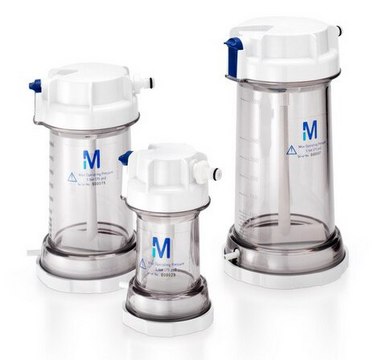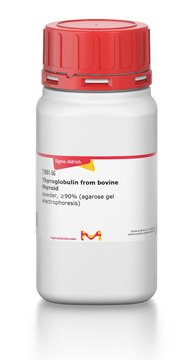HTS083M
ChemiScreen Recombinant Human CCK2 Cholecystokinin Receptor Membrane Preparation
Human CCK2 / CCKb GPCR membrane preparation for Radioligand binding Assays & GTPγS binding.
Se connecterpour consulter vos tarifs contractuels et ceux de votre entreprise/organisme
About This Item
Code UNSPSC :
41106514
eCl@ss :
32161000
Nomenclature NACRES :
NA.84
Produits recommandés
Source biologique
human
Niveau de qualité
Produit recombinant
expressed in Chem-1 cells
Fabricant/nom de marque
ChemiScreen
Chemicon®
Technique(s)
ligand binding assay: suitable (GTPγS)
radioligand binding assay (RLBA): suitable
Numéro d'accès NCBI
Numéro d'accès UniProt
Conditions d'expédition
dry ice
Informations sur le gène
human ... CCKBR(887)
Description générale
Cholecystokinins are a series of peptides of heterogeneous length (5 to 58 amino acids) that are derived from preprocholecystokinin and are found in gastrointestinal tissues and the central nervous system. Gastrin is a related peptide with 5 C-terminal amino acids identical to those of cholecystokinin. Two GPCRs, CCK1 (CCKA) and CCK2 (CCKB), bind to CCK and/or gastrin to mediate the biological effects of the peptides. CCK2 binds to CCK and gastrin with similar affinity, whereas CCK1 selectively binds sulfated CCK. Binding of ligands to CCK2 stimulates mobilization of intracellular calcium by activation of Gq/11. In the periphery, CCK2 is present in the stomach, where it mediates gastrin-stimulated gastric acid secretion. In the CNS, CCK2 has been implicated in anxiety, depression, schizophrenia, depression and opioid analgesia (Noble et al., 1999). Chemicon′s CCK2 membrane preparations are crude membrane preparations made from our proprietary stable recombinant cell lines to ensure high-level of GPCR surface expression; thus, they are ideal HTS tools for screening of antagonists of CCK2 interactions and its ligands. The membrane preparations exhibit a Kd of 0.47 nM for [125I]-cholecystokinin octapeptide (CCK-8). With 0.3 nM [125I]CCK-8, 5 or 10 μg/well CCK2 Membrane Prep yields greater than 20-fold signal-to-background ratio.
Full-length human CCKB cDNA encoding CCK2
Application
Radioligand binding assay and GTPγS binding.
Actions biochimiques/physiologiques
GPCR Class: A
Protein Target: CCK2 / CCKb
Target Sub-Family: Cholecystokinin
Qualité
Signal:background and specific binding values obtained in a competition binding assay with varying amounts of CCK2 membrane prep:
Specifications:
1unit = 5 μg
Bmax for [125I] CCK-8 binding: 3.47 pmol/mg protein
Kd for [125I] CCK-8 binding: ~0.47 nM
| 10 µg/well | 5 µg/well | |
|---|---|---|
| Signal:Background | 27.4 | 27.8 |
| Specific Binding (cpm) | 25,302 | 20,111 |
Specifications:
1unit = 5 μg
Bmax for [125I] CCK-8 binding: 3.47 pmol/mg protein
Kd for [125I] CCK-8 binding: ~0.47 nM
Caractéristiques
Inucbation Conditions
Membranes are mixed with radioactive ligand and unlabeled competitor (see Figures 1 and 2 for concentrations tested) in binding buffer in a nonbinding 96-well plate, and incubated for 1-2 h. Prior to filtration, a GF/C 96-well filter plate is coated with 0.33% polyethyleneimine for 30 min, then washed with 50mM HEPES, pH 7.4, 0.5% BSA. Binding reaction is transferred to the filter plate, and washed 3 times (1 mL per well per wash) with Wash Buffer. The plate is dried and counted.
• Binding buffer: 50 mM Tris, pH 7.4, 10 mM MgCl2, 1 mM EDTA, filtered and stored at 4°C
• Radioligand: [125I]-CCK-8 (Perkin Elmer#:NEX-203 )
• Wash Buffer: 50 mM Tris, pH 7.4 filtered and stored at 4°C.
One package contains enough membranes for at least 200 assays (units), where a unit is the amount of membrane that will yield greater than 20-fold signal:background with 125I labeled CCK-8 at 0.3 nM
Membranes are mixed with radioactive ligand and unlabeled competitor (see Figures 1 and 2 for concentrations tested) in binding buffer in a nonbinding 96-well plate, and incubated for 1-2 h. Prior to filtration, a GF/C 96-well filter plate is coated with 0.33% polyethyleneimine for 30 min, then washed with 50mM HEPES, pH 7.4, 0.5% BSA. Binding reaction is transferred to the filter plate, and washed 3 times (1 mL per well per wash) with Wash Buffer. The plate is dried and counted.
• Binding buffer: 50 mM Tris, pH 7.4, 10 mM MgCl2, 1 mM EDTA, filtered and stored at 4°C
• Radioligand: [125I]-CCK-8 (Perkin Elmer#:NEX-203 )
• Wash Buffer: 50 mM Tris, pH 7.4 filtered and stored at 4°C.
One package contains enough membranes for at least 200 assays (units), where a unit is the amount of membrane that will yield greater than 20-fold signal:background with 125I labeled CCK-8 at 0.3 nM
Forme physique
Liquid in packaging buffer: 50 mM Tris pH 7.4, 10% glycerol and 1% BSA with no preservatives.
Packaging method: Membranes protein were adjusted to 0.5 mg/ml in 1 ml packaging buffer, rapidly frozen, and stored at -80°C.
Packaging method: Membranes protein were adjusted to 0.5 mg/ml in 1 ml packaging buffer, rapidly frozen, and stored at -80°C.
Stockage et stabilité
Maintain frozen at -70°C for up to 2 years. Do not freeze and thaw.
Informations légales
CHEMICON is a registered trademark of Merck KGaA, Darmstadt, Germany
Clause de non-responsabilité
Unless otherwise stated in our catalog or other company documentation accompanying the product(s), our products are intended for research use only and are not to be used for any other purpose, which includes but is not limited to, unauthorized commercial uses, in vitro diagnostic uses, ex vivo or in vivo therapeutic uses or any type of consumption or application to humans or animals.
Code de la classe de stockage
12 - Non Combustible Liquids
Classe de danger pour l'eau (WGK)
WGK 2
Point d'éclair (°F)
Not applicable
Point d'éclair (°C)
Not applicable
Certificats d'analyse (COA)
Recherchez un Certificats d'analyse (COA) en saisissant le numéro de lot du produit. Les numéros de lot figurent sur l'étiquette du produit après les mots "Lot" ou "Batch".
Déjà en possession de ce produit ?
Retrouvez la documentation relative aux produits que vous avez récemment achetés dans la Bibliothèque de documents.
Notre équipe de scientifiques dispose d'une expérience dans tous les secteurs de la recherche, notamment en sciences de la vie, science des matériaux, synthèse chimique, chromatographie, analyse et dans de nombreux autres domaines..
Contacter notre Service technique







